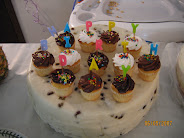Technology decision assignment! It was very meaningful time to make a decision for technology purchase. It helped me think of what really need for students as a teacher.
Actually, it had not been my job to choose technology equipment for a computer lab, it seemed to me it was a lab-technicians' job.
Through this assignment, I could widen my perspective toward educational technology. In addition, it was a good opportunity for me to get responsibility to consider educational technology issues such as how I can use technology well, what I can do for students to make efficient use of the technology, and something like that.
Thursday, October 25, 2007
Wednesday, October 24, 2007
Web 2.0
Web 2.0! I first heard the phrase in our technology classroom. It is almost my first time to think and learn about Web 2.0. So, first of all, I tried to understand what Web 2.0 is exactly. According to Wikipedia,"Web 2.0 refers to a perceived second generation of web-based communities and hosted services — such as social-networking sites, wikis and folksonomies — which aim to facilitate collaboration and sharing between users." MacManus focused on social effects of Web 2.0. He is one of the persons who are strongly believe Web 2.0 is so powerful and effective. He pointed out that "it’s open (or at least it should be), it’s letting go of control over your data, it’s mixing the global with the local. Web 2.0 is about new interfaces - new ways of searching and accessing Web content." (http://blogs.zdnet.com/web2explorer/?p=5) In addition, he noted that "take a look at what the education community is doing with the Web, for example. They are not only starting to use the tools of Web 2.0 - blogs, wikis, podcasts, etc. They’re also adapting to a new generation of kids who are growing up on the Web, the so-called ‘Digital Natives’. The challenge for educators now and for the future is to learn and teach Internet literacy, converse and collaborate with their students using Web tools, and help our children make sense of the huge amounts of information and media that surround us." From several articles about Web 2.0, I noticed that there are sharply divided opinions to Web 2.0. I am still not sure which one is more persuasive in terms of educational points of view. However, one thing, now I am sure is that we need more effective technological tools to build cooperative meanings, construct meaningful learning and communicate extensive knowledge. So, I am really curious that Web 2.0 is a good alternative of WWW for teachers and students. I hope I can get an answer about the question through our class.
*Originally it was posted at the class webvista.
*Originally it was posted at the class webvista.
Thursday, October 4, 2007
What I've thought about readings, discussions, and so on...
This week's discussion and reading topic is about hypertext.
First, I've reflected about myself as a reader after reading the article, "Hypertext and the Changing Roles of Readers." Well, I can say I am a kind of person who is more familiar with paper-type text (traditional text) rather than electronic things. Most of time, I print out weekly reading papers from the WebVister like the author of the article, Patterson. I do not know that that means I am old-fashioned or I am out-of-date or even I am wrong... But I think I need more practice to apply what I've learned about hypertext and something like that.
Second, some questions have occurred to me as a teacher in relation to our discussion. Which is more effective and educational way for students; giving them a strict guide or letting them free to be involved in hypertext. In addition, when kids are involving with hypertexts as readers or writers, how degree we can give them a guideline? Is it enough to give them rubric for helping their learning process? If it is not enough, how I can help students? In my teaching experiences, when my students sat in front of computers, I could not control where they to go anymore. It was so difficult for me to teach something for them with computers because each student had their own mouse.
First, I've reflected about myself as a reader after reading the article, "Hypertext and the Changing Roles of Readers." Well, I can say I am a kind of person who is more familiar with paper-type text (traditional text) rather than electronic things. Most of time, I print out weekly reading papers from the WebVister like the author of the article, Patterson. I do not know that that means I am old-fashioned or I am out-of-date or even I am wrong... But I think I need more practice to apply what I've learned about hypertext and something like that.
Second, some questions have occurred to me as a teacher in relation to our discussion. Which is more effective and educational way for students; giving them a strict guide or letting them free to be involved in hypertext. In addition, when kids are involving with hypertexts as readers or writers, how degree we can give them a guideline? Is it enough to give them rubric for helping their learning process? If it is not enough, how I can help students? In my teaching experiences, when my students sat in front of computers, I could not control where they to go anymore. It was so difficult for me to teach something for them with computers because each student had their own mouse.
Subscribe to:
Comments (Atom)
